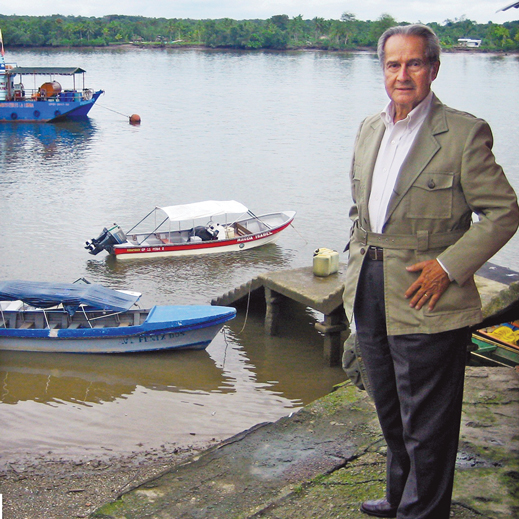Mariano Ospina Hernandez ’49
Civil engineers are trained to think big, and in his 87th year, Mariano Ospina Hernandez is doing just that. After a distinguished career in Colombian business, politics, and diplomacy, he is leading an international initiative to link South America’s major rivers into a transportation network running from Venezuela to Buenos Aires.

The proposed South American Waterway System (SAWS) would open new connections for a continent that has struggled with economic integration and development. In addition to boosting exports and intracontinental trade and travel, it would be far more fuel-efficient than road or rail transport.
“The U.S. has about five million kilometers of highways; all of South America has about 400,000,” explains Ospina. “By linking six major rivers (Amazon, Orinoco, Putumayo, Paraguay, Paraná, and La Plata), we can create 40,000 kilometers of navigable waterways that can carry as much as a four-million-kilometer highway network.”
The project requires extensive civil engineering work, notes Ospina, plus “political engineering, obtaining agreement of all these countries to work together, and financial engineering, to arrange the necessary $50 billion to $60 billion and ensure ROI.”
Ecological and social questions also abound. Ospina has enlisted MIT and Harvard faculty—including his mentor, MIT professor of civil and environmental engineering Fred Moavenzadeh—for analytical and planning assistance. The work dates to 1994, when Ospina lived in Cambridge, researching protection and development of South American jungles and rivers.
SAWS has won widespread interest, and the Colombian government is reviewing a report and proposal that would open the door to a formal feasibility study.
Ospina is uniquely prepared for the project. In addition to earning a Course 1 SB, a biology degree from the University of Bogotá, and a Harvard master’s in city planning, he has run several construction firms and a coffee company, been CEO of the Agricultural Bank of Colombia, held local and national elected office, and served as Colombia’s ambassador to West Germany. Today he heads the Fundación Mariano Ospina Pérez, which carries on rural and social development work in the name of his father, Colombia’s president from 1946 to 1950.
“I feel very happy to have worked in so many areas,” says Ospina, who credits some of his vigor to living in the “eternal springtime” of Bogotá, some 2,600 meters above sea level. He spends as much time as possible with his wife, Helena, six children, 19 grandchildren, and four great-grandchildren.
Keep Reading
Most Popular
Large language models can do jaw-dropping things. But nobody knows exactly why.
And that's a problem. Figuring it out is one of the biggest scientific puzzles of our time and a crucial step towards controlling more powerful future models.
The problem with plug-in hybrids? Their drivers.
Plug-in hybrids are often sold as a transition to EVs, but new data from Europe shows we’re still underestimating the emissions they produce.
How scientists traced a mysterious covid case back to six toilets
When wastewater surveillance turns into a hunt for a single infected individual, the ethics get tricky.
Google DeepMind’s new generative model makes Super Mario–like games from scratch
Genie learns how to control games by watching hours and hours of video. It could help train next-gen robots too.
Stay connected
Get the latest updates from
MIT Technology Review
Discover special offers, top stories, upcoming events, and more.